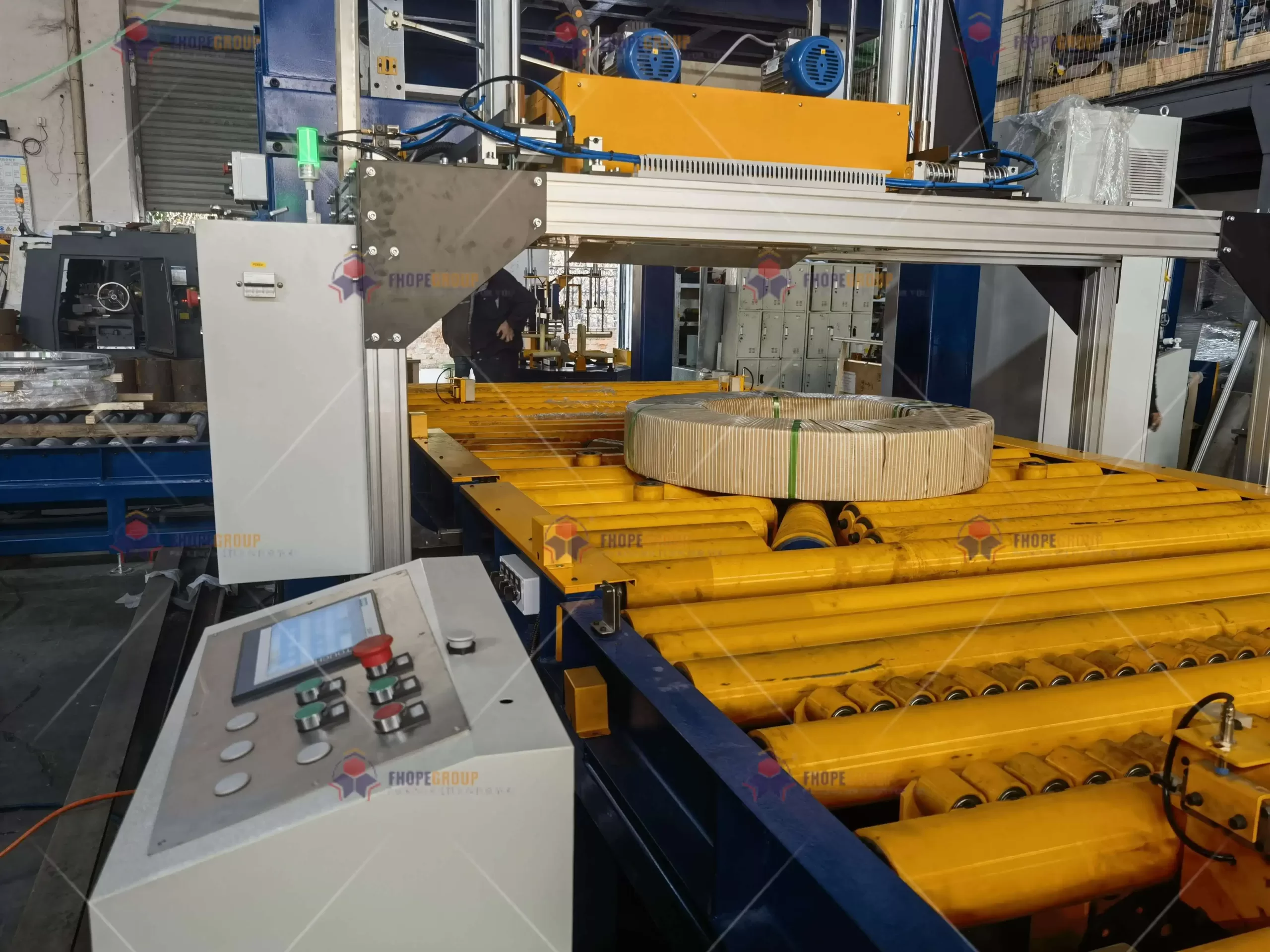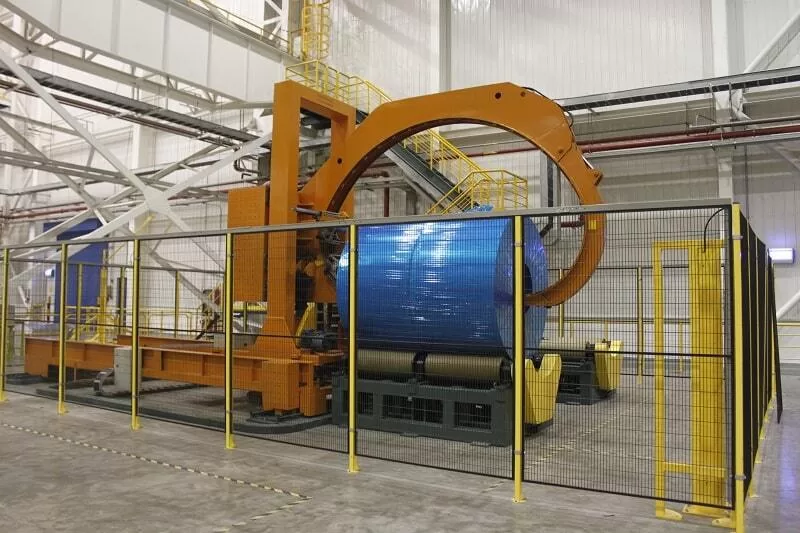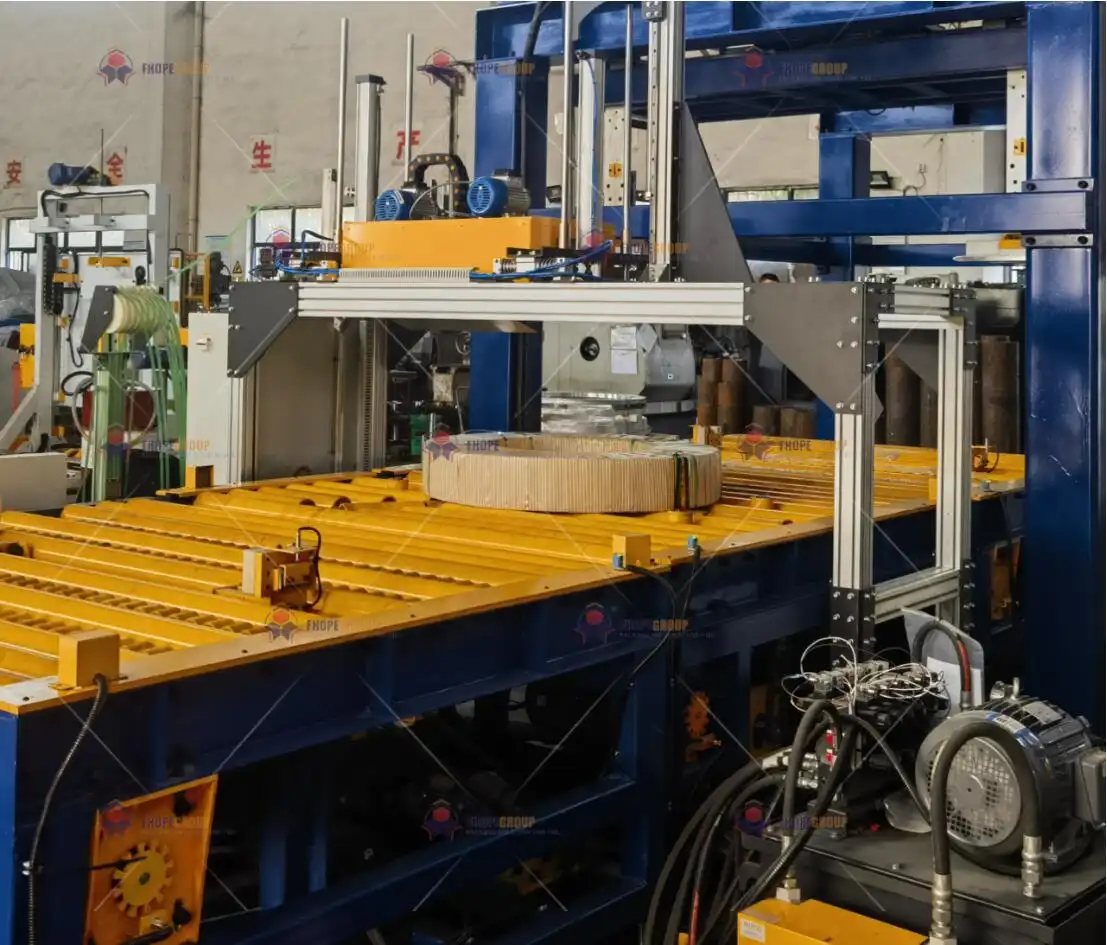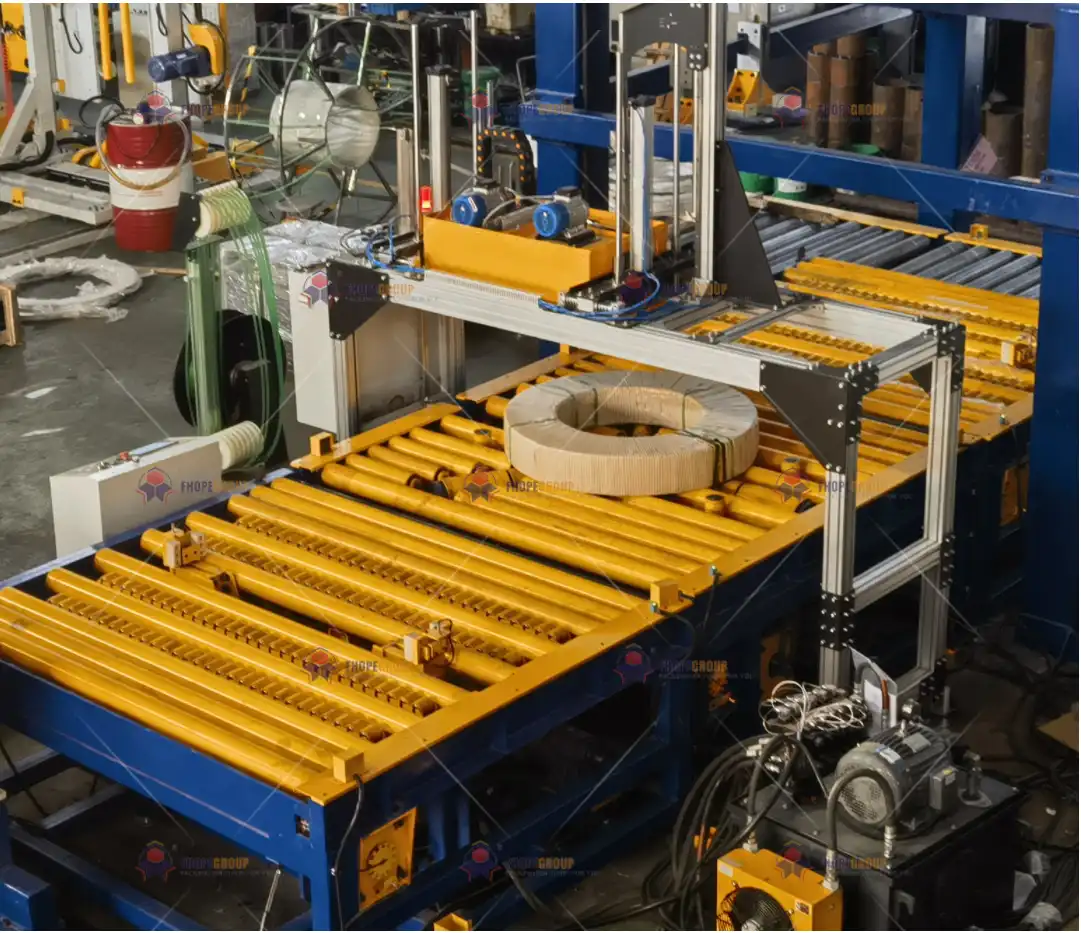Are you a procurement manager in Russia's demanding steel or heavy manufacturing industry? You are likely under constant pressure to improve efficiency and cut costs. But you know the risks of choosing the cheapest option. You have probably seen how manual packing processes create production bottlenecks, lead to dangerous workplace accidents, and cause damage to your valuable steel coils. Every minute of downtime costs a fortune. Every safety incident hurts team morale and your budget. Every damaged coil erodes your profits and, worse, your customers' trust. It feels like a trap, stuck between the pressure to save money now and the need for a reliable solution that will last. But what if there was a way to invest in a coil packing line that not only solves these problems but also delivers a clear, fast return on your investment?
Russian procurement teams can maximize their return on investment (ROI) by adopting a holistic view that looks beyond the initial purchase price of a coil packing line. The key is to select a durable, automated system that drastically reduces long-term labor costs, eliminates product damage, enhances workplace safety, and boosts overall production throughput. To achieve this, you must partner with a supplier who provides a total solution—from expert consultation and customization to reliable, long-term after-sales support.

This might sound simple, but my journey in this industry has taught me something important. I started as an engineer on the factory floor and eventually built my own successful packing machine factory. I learned that the real value of an investment is found in the details. A high ROI is not just about the machine itself; it is about the strategy behind the investment. It’s about understanding the total cost and the total value. Let's break down how you can approach this to ensure your investment pays off for many years, turning a simple purchase into a powerful asset for your company's growth.
Why Does Focusing Only on Upfront Cost Lead to Failure?
The pressure from management to meet strict budget targets can be intense. It is very tempting to look at a list of quotes and simply choose the one with the lowest price tag. It feels like an easy win, a quick way to show you are saving the company money. But I have seen this story play out too many times, and it rarely has a happy ending. The cheap machine arrives, and for a short time, things seem fine. Then, the problems begin. It breaks down frequently. You try to get spare parts, but they are difficult to find or take weeks to arrive. The supplier’s "customer support" line goes unanswered. All the while, your production line is stopped, orders are delayed, and your team is frustrated. The initial "savings" are quickly wiped out by massive losses from downtime and repairs. A true ROI calculation must look at the Total Cost of Ownership (TCO), not just the sticker price.
Focusing only on the upfront cost of a packing line leads to failure because it completely ignores the critical long-term expenses that determine a machine's true value. These hidden costs include frequent downtime, high maintenance and repair bills, the need for more operators, excessive energy consumption, and the financial impact of product damage from an unreliable line. A lower initial price often signals inferior components and poor support, which results in a much higher Total Cost of Ownership and, ultimately, a negative ROI.

Diving Deeper: The Hidden Iceberg of Total Cost of Ownership
Think of the machine's price as just the tip of an iceberg. It’s the part you can see easily. But the real danger, the part that can sink your investment, is the massive amount of cost hidden below the surface. When I was building my own factory, I had to learn this lesson the hard way. I focused too much on initial savings and paid for it later. A smart procurement team learns to see the whole iceberg.
The True Cost Breakdown
The initial purchase price is straightforward. But the submerged costs are what really impact your ROI over the machine's 15- to 20-year lifespan. Let's break them down.
- Maintenance & Repairs: A machine built with cheaper components will fail more often. It's a simple fact. This means more money spent on spare parts and more hours spent by your maintenance team fixing it instead of performing preventative work.
- Downtime Costs: This is the biggest hidden cost. Every hour your packing line is down, your entire production process can grind to a halt. How much does that cost? You can calculate it: (Units per hour) x (Profit per unit) x (Hours of downtime). The number is often shockingly high. A reliable machine might cost more upfront, but it prevents these catastrophic losses.
- Labor Costs: An inefficient or poorly designed machine often requires more people to operate it. It might need constant supervision or manual assistance. An automated, reliable line can often be managed by a single operator, freeing up your valuable team members for other tasks.
- Product Damage: A poorly built packing line with rough contact surfaces or jerky movements can scratch, dent, or damage the edges of your steel coils. Every damaged coil is a direct loss of profit and can lead to customer complaints.
- Energy Consumption: Lower-quality motors, drives, and components are often less energy-efficient. Over thousands of hours of operation, this adds up to a significant and unnecessary expense on your factory's electricity bill.
- Replacement Cycle: A cheap machine might last only 5-7 years under the harsh conditions of a steel mill. A high-quality, durable machine can last 15 years or more. Buying one good machine is far cheaper in the long run than buying three cheap ones.
Here is a simple table to illustrate the point:
| Cost Factor | Low-Price Machine (Example) | Quality Machine (Example) |
|---|---|---|
| Initial Price | $80,000 | $150,000 |
| Annual Maintenance | $5,000 | $1,500 |
| Annual Downtime Cost | $40,000 (80 hours) | $5,000 (10 hours) |
| Excess Labor Cost | $15,000 (1 extra operator) | $0 |
| Product Damage Loss | $10,000 | $1,000 |
| 5-Year TCO | $430,000 | $212,500 |
As you can see, the machine that looked "cheaper" actually costs twice as much over just five years. A procurement manager who understands this is a true asset to their company.
How Does an Automated Packing Line Directly Improve Safety and Reduce Labor Costs?
Think about your factory floor. It is a high-risk environment. Your team works around heavy machinery and massive steel coils that can weigh several tons. The manual handling of these coils—pushing, turning, and strapping them by hand—is a primary source of workplace injuries. As a manager, you are constantly worried about your team's safety. The associated costs of accidents, from high insurance premiums to employee turnover, are a constant drain on your factory's resources. A single serious accident can be devastating, not just financially but for the morale of your entire workforce. At the same time, finding and keeping good workers for such physically demanding and repetitive jobs is getting harder and more expensive every year. Automation offers a direct and powerful solution to both of these critical problems.
An automated packing line directly improves workplace safety by completely eliminating the need for manual lifting, turning, and strapping of heavy steel coils, which are the leading causes of serious musculoskeletal injuries in metal processing plants. This drastic reduction in manual handling minimizes accident risks and lowers insurance premiums. Simultaneously, automation reduces labor costs by taking over repetitive tasks, which allows a smaller, more skilled team to manage the entire end-of-line process. This lowers payroll expenses and helps solve the challenge of labor shortages.

Diving Deeper: Transforming Your Workforce and Workplace
The decision to automate is not just about replacing people with machines. It is about creating a safer, more efficient, and more modern work environment. It's about empowering your team to do higher-value work.
The Human Cost of Manual Packing
Let's visualize the old way of doing things. A crane drops a heavy coil onto the floor. A team of two or three workers then has to manually position it, often using pry bars. They use heavy, manual strapping tools, which puts immense strain on their backs, arms, and shoulders. They might have to wrap the coil with film by walking around it again and again. Every step of this process is filled with risk: a coil could tip, a strap could snap, or a worker could suffer a severe strain injury from the repetitive motion. This leads to what managers like Michael Chen fear most: high workers' compensation claims, lost workdays, and a constant cycle of hiring and training new employees because the job is simply too difficult and dangerous.
Automation as the Logical Solution
Now, let's visualize the automated process. The coil moves from your slitting line onto a conveyor. It is automatically centered and then moved to a strapping station, where a machine applies the straps perfectly every time. Next, it moves to an orbital wrapping machine that wraps the coil securely in seconds. Finally, it is transported to a stacking station, ready for shipment. The entire process is supervised by a single operator standing at a safe distance, managing the line from a control panel.
The comparison is clear:
| Feature | Manual Process | Automated Line |
|---|---|---|
| Coil Handling | Crane + Manual pushing/turning | Conveyors, tilters, turnstiles |
| Strapping | Hand tools, high physical effort | Automatic strapping heads |
| Wrapping | Manual film wrapping, inconsistent | Orbital wrapping machine, uniform |
| Safety Risk | High (strains, cuts, crushing) | Minimal (operators supervise) |
| Labor Required | 3-4 workers per shift | 1 supervisor per line |
| Speed & Consistency | Slow, varies by worker | Fast, consistently high quality |
When I automated the packing line in my own factory, the change was incredible. Not only did our productivity increase, but the atmosphere on the factory floor changed. My team members were no longer exhausted from hard physical labor. We trained them to become skilled machine operators and maintenance technicians. Their jobs became more engaging and less dangerous. Morale improved, and our employee retention rate went up. By investing in automation, you are not just investing in a machine; you are investing in the safety and well-being of your people.
What Key Features Should You Demand in a Coil Packing Line for Maximum Durability?
Perhaps you have been burned before. You bought a machine from a supplier who promised reliability, but it couldn't handle the tough, non-stop environment of your plant. Now, you are rightfully skeptical of sales pitches and marketing brochures. A steel mill in Russia is not a gentle place. The equipment faces extreme temperature swings, constant dust and debris, and the demand for 24/7 operation. A standard, lightly-built machine will not survive. It will wear out quickly, leading you right back to the downtime and repair headaches you are trying to escape. To avoid this costly mistake, you need to know exactly what to look for. Let's go beyond the sales pitch and talk about the specific engineering features that define a truly durable and reliable coil packing line.
For maximum durability in a demanding industrial environment, a coil packing line must be built with a heavy-duty, reinforced steel frame. It should use high-quality, internationally recognized brand components, such as Siemens PLCs and SEW motors, and feature robust, wear-resistant materials like polyurethane-coated rollers for all contact surfaces. Furthermore, you should demand critical features like sealed bearings to protect against dust, a simplified mechanical design that allows for easy maintenance, and a comprehensive sensor system for self-diagnosis and operational safety.

Diving Deeper: The Anatomy of a Bulletproof Machine
As an engineer, this is what I get passionate about. A machine's durability is not an accident; it is the result of intelligent design and quality construction. Here are the non-negotiable features you should look for.
The Frame is the Foundation
The entire machine relies on its frame for stability. A weak or flimsy frame will flex under the load of heavy coils. This causes misalignment in critical components like conveyors and strapping heads, leading to premature wear and tear.
- What to demand: Ask about the thickness of the steel used. For a heavy-duty line, the main structure should be built from thick steel plates, not just thin tubes. All joints should be professionally welded for maximum rigidity.
Components Matter Most
A machine is only as strong as its weakest part. Even with a great frame, low-quality components will cause endless problems.
- Motors and Drives: These are the muscles of your machine. I always recommend using proven, international brands like SEW-Eurodrive or Siemens. They are more energy-efficient, more reliable, and built to last under continuous load.
- PLC and Controls: The PLC is the brain. A stable, well-programmed control system is essential. Using a globally recognized brand like Siemens or Allen-Bradley ensures reliability and makes it easier to find support and spare parts.
- Bearings and Rollers: In a dusty steel mill, unsealed bearings will fail quickly. Insist on high-quality sealed bearings. For all rollers that contact your steel coils, they should be coated with a thick layer of durable polyurethane (PU). This protects the surface of your product and also reduces wear on the rollers themselves.
Design for Maintenance
Even the best machine needs maintenance. I once bought a machine for my factory where changing a simple belt required disassembling half of the unit. It was a maintenance nightmare. A great design provides easy access to all key service points—motors, gearboxes, and sensors. This makes preventative maintenance faster and easier for your team.
| Feature to Check | Why It's Critical | What to Ask the Supplier |
|---|---|---|
| Frame Construction | Provides stability and longevity | "What is the steel thickness and grade? Are joints welded or bolted?" |
| Motor/Drive Brand | Ensures reliability and energy efficiency | "Which brands do you use for motors and drives and why?" |
| PLC & Control System | Guarantees system stability and support | "What PLC is used? Is the program code accessible for our technicians?" |
| Roller Material | Protects your product and reduces wear | "Are the conveyor rollers PU-coated? What is the hardness rating?" |
| Environmental Protection | Ensures durability in harsh conditions | "Are all bearings sealed? Is the electrical cabinet heated for low temperatures?" |
Especially for the Russian market, you must consider the climate. Ask if components are rated for low-temperature operation. Electrical cabinets should be properly sealed and may require internal heaters to ensure the electronics function reliably in an unheated warehouse during winter. Demanding these features ensures you get a machine built for your world, not for a clean-room laboratory.
My Insights: Why Your Supplier is More Important Than the Machine Itself?
So, you have done your homework. You have created a detailed list of technical specifications. You have a clear budget approved. You are ready to purchase a new coil packing line. But let me ask you a critical question: what happens after the sale? What happens when you have an unexpected technical issue in the middle of a night shift? Who will you call when you need to train a new operator six months from now? What happens when you want to upgrade or modify the line in five years to handle a new product? A machine is just steel, wires, and programming. Without a true, committed partner standing behind it, that machine can quickly become a very expensive and frustrating problem. This is the single biggest mistake I see companies make.
From my own experience building a factory from the ground up, I learned this lesson: your supplier is more important than the machine itself. A machine's performance over its 15- to 20-year life depends almost entirely on the quality of the supplier's support. A true partner provides expert consultation to solve your unique problems, offers fast and reliable after-sales service, and acts as a long-term advisor for your company's growth. They don’t just sell you a machine; they invest in your success. That is the ultimate guarantee of your ROI.

Diving Deeper: From Employee to Factory Owner—A Lesson in Partnership
My perspective comes from seeing both sides of this industry. I started my career as an engineer on the factory floor, working with machines from many different suppliers. I saw firsthand what separated the good suppliers from the bad. Later, when I took the big step of establishing my own packing machine factory, I had to live with the consequences of my own purchasing decisions.
I remember one situation early on that I will never forget. I had purchased a key machine for my production line from a supplier who gave me a fantastic price. Six months later, it broke down on a Friday afternoon. We had a huge, time-sensitive order that had to ship out on Monday. I called the supplier's service line. No answer. I sent emails. No reply until late Monday morning. By then, it was too late. We missed the deadline, damaged our relationship with a key customer, and lost a significant amount of money. The "great price" I got on that machine ended up costing me dearly.
This experience taught me that the real value is not in the hardware; it is in the partnership. A machine is a tool, but a great supplier is a resource that helps your business grow.
What Defines a "Total Solution" Partner?
A true partner is engaged with you before, during, and long after the sale.
- 1. Before the Sale: The Consultant. A real partner doesn't just email you a standard quote. They seek to understand your business. They ask about your specific production bottlenecks, your material flow, your safety concerns, and your long-term goals. They act as a knowledgeable consultant, helping you design the best possible solution, not just the one they want to sell. They solve your problem first.
- 2. During the Sale: The Project Manager. Once you move forward, a partner manages the project professionally. They provide clear timelines, transparent communication, and comprehensive documentation. The installation, commissioning, and training for your team are handled smoothly and efficiently, ensuring the machine is running perfectly from day one.
- 3. After the Sale: The Long-Term Ally. This is the most critical stage. This is where you separate a vendor from a partner. A partner provides:
- Responsive Support: They have technical experts available to help you troubleshoot problems quickly, minimizing downtime.
- Reliable Spare Parts: They maintain a stock of critical spare parts and can ship them to you immediately.
- Proactive Advice: They stay in touch. They check in to see how the machine is performing. They offer advice on preventative maintenance and inform you about new technology or upgrades that could benefit your operation.
When you evaluate suppliers, don't just ask about the machine's price. Ask them about their support process, their spare parts guarantee, and their philosophy on partnership. Choose the company you want to be working with in ten years, because a good machine will still be running then, and a good partner will still be there to support you.
Conclusion
Investing in a coil packing line is a major decision. By focusing on total cost, safety, durability, and a true partnership, you ensure it's not an expense, but a powerful engine for your factory's growth.





